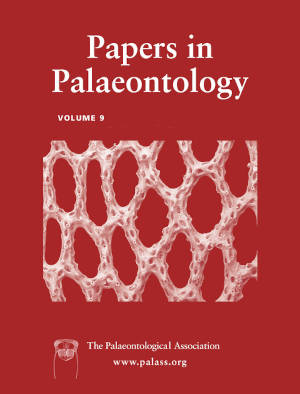Article: Bivalves from the Changhsingian (upper Permian) Bellerophon Formation of the Dolomites (Italy): ancestors of Lower Triassic post-extinction benthic communities
Publication: Papers in Palaeontology
Volume:
9
Part:
2
Publication Date:
2023
Article number:
e1486
Author(s):
Herwig Prinoth, and Renato Posenato
DOI:
10.1002/spp2.1486
Abstract
Abstract Diverse shallow marine fossil assemblages from the Changhsingian Bellerophon Formation (Dolomites) record late Palaeozoic marine life immediately before the end-Permian mass extinction. We classified c. 6500 bivalves from western Dolomites localities, identifying 26 species including one new family (Ladinomyidae), three new genera (Ladinomya, Lovaralucina, Gardenapecten) and 10 new species: Acharax frenademezi, Bakevellia (Bakevellia) preromangica, Edmondia hautmanni, Etheripecten stuflesseri, Ladinomya fosteri, Lovaralucina covidi, Palaeolima badiotica, Promytilus merlai, Tambanella? stetteneckensis and Volsellina carinata. The occurrence of three Eumorphotis species with different stratigraphic distributions, leads us to propose an upper Permian ‘Lower Eumorphotis Zone’, divided into E. praecurrens, E. striatocostata and E. lorigae subzones, and distinct from the existing Lower Triassic Eumorphotis Zone (here renamed ‘Upper Eumorphotis Zone’). Palaeoecological analysis produced six biofacies and four ecofacies, based on richness, dominance and ecological lifestyle. The bivalves inhabited lagoonal to nearshore environments affected by stressed conditions: high temperatures, high salinity, shallow water depths, low oxygen and high terrigenous input. The upper Bellerophon Fm is characterized by increasingly fully marine conditions, although eurytopic taxa still suggest stressed conditions. Bivalve richness of the upper Permian Bellerophon and Lower Triassic Werfen formations was compared to estimate the genus-level extinction rate. The disappearance of almost half (47%) of Bellerophon Fm genera is remarkably low compared with other, coeval bivalve faunas. Pre-extinction bivalve faunas were dominated by stress-adapted taxa (Unionites, Eumorphotis, Bakevellia, Towapteria) able to thrive in extreme environmental conditions, survive the end-Permian mass extinction, and become the dominant biotic component of Lower Triassic benthic communities globally.
